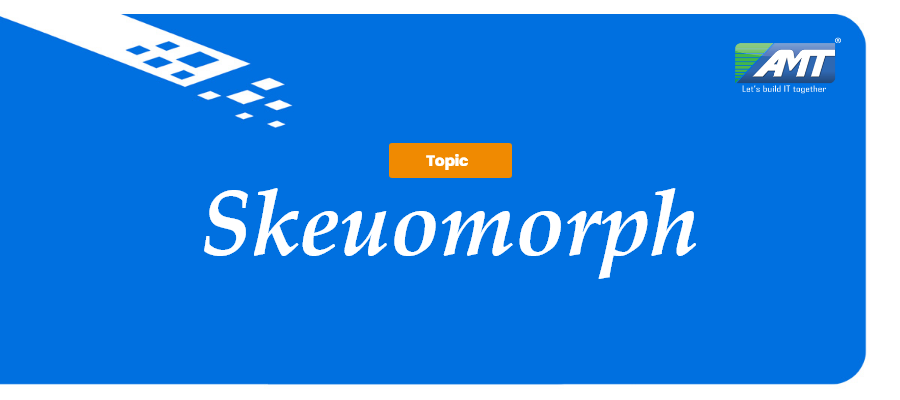A Skeuomorph is a derivative object that retains nonfunctional ornamental design cues (attributes) from structures that were inherent to the original. Examples include pottery embellished with imitation rivets reminiscent of similar pots made of metal and a software calendar that imitates the appearance of binding on a paper desk calendar.
Skeuomorphs may be deliberately employed to make a new look more familiar and comfortable, or may be the result of cultural influences and norms on the designer. They may be artistic expression on the part of the designer. The usability researcher and academic Don Norman describes skeuomorphism in terms of cultural constraints: interactions with a system that are learned only through culture. Norman also popularized perceived affordances, where the user can tell what an object provides or does based on its appearance, which skeuomorphism can make easy.
The concept of skeuomorphism overlaps with other design concepts. Mimesis is an imitation, coming directly from the Greek word. Archetype is the original idea or model that is emulated, where the emulations can be skeuomorphic. Skeuomorphism is parallel to, but different from, path dependence in technology, where an element’s functional behavior is maintained even when the original reasons for its design no longer exist.
Physical Skeuomorphs:
Many features of wooden buildings were repeated in stone by the Ancient Greeks when they transitioned from wood to masonry construction. Decorative stone features in the Doric order of classical architecture in Greek temples such as triglyphs, mutules, guttae, and modillions are supposed to be derived from true structural and functional features of the early wooden temples. The triglyph and guttae are seen as recreating in stone functional features of the wooden temples that preceded them, respectively the carved beam-ends and six wooden pegs driven in to secure the beam in place.
Historically, high-status items such as the Minoans’ elaborate and expensive silver cups were recreated for a wider market using pottery, a cheaper material. The exchange of shapes between metalwork and ceramics, often from the former to the latter, is near-constant in the history of the decorative arts. Sometimes pellets of clay are used to evoke the rivets of the metal originals.
There is also evidence of skeuomorphism in material transitions. Leather and pottery often carry over features from the wooden counterparts of previous generations. Clay pottery has also been found bearing rope-shaped protrusions, pointing to craftsmen seeking familiar shapes and processes while working with new materials. In this context, skeuomorphs exist as traits sought in other objects, either for their social desirability or psychological comforts.
Virtual Skeuomorphs:
Many computer programs have a skeuomorphic graphical user interface that emulates the aesthetics of physical objects. Examples include a digital contact list resembling a Rolodex, and IBM’s 1998 RealThings package. A more extreme example is found in some music synthesis and audio processing software packages, which closely emulate physical musical instruments and audio equipment complete with buttons and dials.
Apple Inc, while under the direction of Steve Jobs, was known for its wide usage of skeuomorphic designs in various applications. This changed after Jobs’ death when Scott Forstall, described as “the most vocal and high-ranking proponent of the visual design style favored by Mr. Jobs”, resigned. Apple designer Jonathan Ive took over some of Forstall’s responsibilities and had “made his distaste for the visual ornamentation in Apple’s mobile software known within the company”. With the announcement of iOS 7 at WWDC in 2013, Apple officially shifted from skeuomorphism to a more simplified design, thus beginning the so-called “death of skeuomorphism” at Apple.
Other virtual skeuomorphs do not employ literal images of some physical object; but rather allude to ritual human heuristics or heuristic motifs, such as slider bars that emulate linear potentiometers and visual tabs that behave like physical tabbed file folders. Another example is the swiping hand gesture for turning the “pages” or screens of a tablet display.
Virtual skeuomorphs can also be auditory. The shutter-click sound emitted by most camera phones when taking a picture is an auditory skeuomorph.
Retrofuturism incorporates spatial motifs from previous iterations of the future; especially visions of electro-industrialism. This is frequently incorporated in retrowave or synthwave illustrations. Skeumorphic time is closely linked with metamodernism.
Skeuomorphic design seems to be preferred by older recipient groups often referred to as digital immigrants while digital natives tend to favor flat design over skeuomorphisms. However, younger people are still able to understand the signifiers that skeuomorphic design employs. A better user experience could be measured for each respective design philosophy among digital natives and immigrants.
The above is a brief about Skeuomorph. Watch this space for more updates on the latest trends in Technology.
